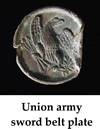Broadway

The area around former Broadway Landing on the Appomattox River is believed to be the site of one of the earliest colonial occupations in present Hopewell. Nearby along Bull Run Creek, the mid-seventeenth century City Church stood until the Civil War. From the seventeenth through nineteenth centuries, a small port community thrived. In 1753, the town of Broadway was incorporated, and a ferry service crossed the Appomattox. During the Civil War, the Union army used Broadway as a key depot/transhipment point connected to Bermuda Hundred by a pontoon bridge.
Today the Broadway area consists of several private properties. Local landowners have been generous with their permission to allow archaeological survey. To date, two of these properties have been fully examined with systematic shovel tests.
The first property to be investigated for archaeological sites is the Koehler tract. It encompasses approximately 3.7 acres with direct frontage on the Appomattox River, just upstream from the historic landing area. Shovel tests across the Koehler land revealed an unbroken scatter of prehistoric debris. Most of it consists of the by-products of stone tool manufacture - broken tools and flakes from the production process. Ancient exposures along the Appomattox contain deposits of large quartzite cobbles from which Indians could fashion their tools. What amounts to a workshop area at one of these exposures is now documented on this property. Most of the stone working appears to have occurred between 5000 and 1500 years ago.
 Historic period artifacts on this property were less common but document activity during at least the 18th century and probably the Civil War. In one area artifacts dating from the late 1700s indicate that a small dwelling was located there. The identity of the occupants is not yet known but they may have been tenants and laborers on a larger plantation. It was known before we began the Koehler survey that a cemetery was located on the property. The location of it was reestablished by our work. The dates of the graves are uncertain but there is reason to believe that this burying ground saw initial use in the colonial period. Civil War era artifacts in the form of broken bottles and the like were recovered here and there.
Historic period artifacts on this property were less common but document activity during at least the 18th century and probably the Civil War. In one area artifacts dating from the late 1700s indicate that a small dwelling was located there. The identity of the occupants is not yet known but they may have been tenants and laborers on a larger plantation. It was known before we began the Koehler survey that a cemetery was located on the property. The location of it was reestablished by our work. The dates of the graves are uncertain but there is reason to believe that this burying ground saw initial use in the colonial period. Civil War era artifacts in the form of broken bottles and the like were recovered here and there.  The low density of this material and its scattered nature indicate that this particular tract was not heavily utilized during the conflict.
The low density of this material and its scattered nature indicate that this particular tract was not heavily utilized during the conflict.
The second property near Broadway Landing subjected to archaeological survey is the Williamson property. This small parcel (about 1.2 acres) situated back from the river front was also systematically shovel tested. Much less prehistoric debris was encountered although it was present. Most artifacts date from the historic period, especially the 19th century. More than likely this evidence represents occupation over much of that century. Very clearly, however, there is a stronger indication of Civil War activity. This was revealed by a small collection of military items generously donated to the project by the present landowners.
 Skip to main content
Skip to main content
